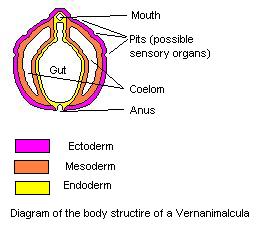Vernanimalcula
Vernanimalcula is a genus of small, bilaterian animals from the Ediacaran period. The name Vernanimalcula means "springtime tiny animal" and is derived from the Latin words verna (spring), animal (animal), and cula (diminutive suffix). The genus is known from fossil evidence found in the Doushantuo Formation in China.
Discovery[edit | edit source]
The fossils of Vernanimalcula were discovered in the Doushantuo Formation, which dates back to approximately 600 million years ago, during the Ediacaran period. The discovery was significant because it provided evidence of complex, multicellular life forms existing before the Cambrian explosion.
Morphology[edit | edit source]
Vernanimalcula fossils are characterized by their small size, typically less than 1 millimeter in length. The fossils exhibit bilateral symmetry, which is a key feature of bilaterian animals. The body structure includes a distinct anterior and posterior end, as well as a possible mouth and gut cavity, suggesting a more complex organization compared to other Ediacaran biota.
Significance[edit | edit source]
The discovery of Vernanimalcula has important implications for the understanding of early animal evolution. It suggests that bilaterian animals, which include most modern animal phyla, may have originated earlier than previously thought. This challenges the traditional view that complex animals rapidly diversified during the Cambrian explosion.
Controversy[edit | edit source]
The interpretation of Vernanimalcula as a bilaterian animal has been subject to debate. Some paleontologists argue that the fossils may represent simpler organisms or even non-biological structures. Further research and more fossil evidence are needed to resolve these controversies.
See also[edit | edit source]
References[edit | edit source]
External links[edit | edit source]
This article is a paleontology stub. You can help WikiMD by expanding it!
Search WikiMD
Ad.Tired of being Overweight? Try W8MD's physician weight loss program.
Semaglutide (Ozempic / Wegovy and Tirzepatide (Mounjaro / Zepbound) available.
Advertise on WikiMD
|
WikiMD's Wellness Encyclopedia |
| Let Food Be Thy Medicine Medicine Thy Food - Hippocrates |
Translate this page: - East Asian
中文,
日本,
한국어,
South Asian
हिन्दी,
தமிழ்,
తెలుగు,
Urdu,
ಕನ್ನಡ,
Southeast Asian
Indonesian,
Vietnamese,
Thai,
မြန်မာဘာသာ,
বাংলা
European
español,
Deutsch,
français,
Greek,
português do Brasil,
polski,
română,
русский,
Nederlands,
norsk,
svenska,
suomi,
Italian
Middle Eastern & African
عربى,
Turkish,
Persian,
Hebrew,
Afrikaans,
isiZulu,
Kiswahili,
Other
Bulgarian,
Hungarian,
Czech,
Swedish,
മലയാളം,
मराठी,
ਪੰਜਾਬੀ,
ગુજરાતી,
Portuguese,
Ukrainian
Medical Disclaimer: WikiMD is not a substitute for professional medical advice. The information on WikiMD is provided as an information resource only, may be incorrect, outdated or misleading, and is not to be used or relied on for any diagnostic or treatment purposes. Please consult your health care provider before making any healthcare decisions or for guidance about a specific medical condition. WikiMD expressly disclaims responsibility, and shall have no liability, for any damages, loss, injury, or liability whatsoever suffered as a result of your reliance on the information contained in this site. By visiting this site you agree to the foregoing terms and conditions, which may from time to time be changed or supplemented by WikiMD. If you do not agree to the foregoing terms and conditions, you should not enter or use this site. See full disclaimer.
Credits:Most images are courtesy of Wikimedia commons, and templates Wikipedia, licensed under CC BY SA or similar.
Contributors: Prab R. Tumpati, MD

